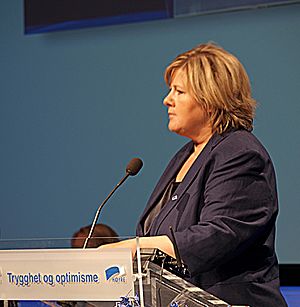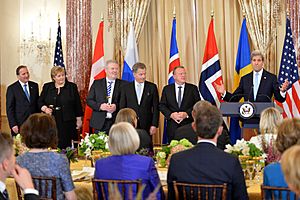Erna Solberg facts for kids
Quick facts for kids
Erna Solberg
|
|
|---|---|

Solberg in 2025
|
|
| Prime Minister of Norway | |
| In office 16 October 2013 – 14 October 2021 |
|
| Monarch | Harald V |
| Preceded by | Jens Stoltenberg |
| Succeeded by | Jonas Gahr Støre |
| Leader of the Opposition | |
| Assumed office 14 October 2021 |
|
| Monarch | Harald V |
| Prime Minister | Jonas Gahr Støre |
| Preceded by | Jonas Gahr Støre |
| In office 17 October 2005 – 16 October 2013 |
|
| Monarch | Harald V |
| Prime Minister | Jens Stoltenberg |
| Preceded by | Jens Stoltenberg |
| Succeeded by | Jens Stoltenberg |
| Leader of the Conservative Party | |
| Assumed office 9 May 2004 |
|
| First Deputy | Per-Kristian Foss Jan Tore Sanner Henrik Asheim |
| Second Deputy | Jan Tore Sanner Erling Lae Bent Høie Tina Bru |
| Preceded by | Jan Petersen |
| Minister of Local Government and Regional Development |
|
| In office 19 October 2001 – 17 October 2005 |
|
| Prime Minister | Kjell Magne Bondevik |
| Preceded by | Sylvia Brustad |
| Succeeded by | Åslaug Haga |
| Leader of the Conservative Women's Association | |
| In office 7 March 1993 – 29 March 1998 |
|
| Preceded by | Siri Frost Sterri |
| Succeeded by | Sonja Sjøli |
| Member of the Storting | |
| Assumed office 2 October 1989 |
|
| Deputy | Silja Ekeland Bjørkly Eli Årdal Berland Erik Skutle Liv Kari Eskeland Charlotte Spurkeland |
| Constituency | Hordaland |
| Personal details | |
| Born | 24 February 1961 Bergen, Hordaland, Norway |
| Political party | Conservative |
| Spouse |
Sindre Finnes
(m. 1996) |
| Children | 2 |
| Alma mater | University of Bergen |
| Website | https://erna.no/ |
Erna Solberg was born on February 24, 1961. She is a Norwegian politician and the current Leader of the Opposition in Norway. She served as the prime minister of Norway from 2013 to 2021. She has also been the leader of the Conservative Party since May 2004.
Solberg was first elected to the Storting (the Norwegian Parliament) in 1989. Before becoming prime minister, she was the Minister of Local Government and Regional Development from 2001 to 2005. During this time, she worked on policies related to local communities and how Norway is organized. After the 2005 election, she led the Conservative Party's group in Parliament until 2013.
After winning the election in September 2013, Solberg became Norway's prime minister. She was the second woman to hold this important position. Her government was re-elected in 2017. In 2021, her government lost its majority in Parliament, and she stepped down. She then became the Leader of the Opposition.
Contents
Early Life and Education
Erna Solberg was born in Bergen, Norway, on February 24, 1961. She grew up in the Kalfaret area. Her father was a consultant, and her mother worked in an office. She has two sisters.
Solberg faced some challenges at school. At 16, she learned she had dyslexia, which means she sometimes had difficulty with reading and writing. Despite this, she was an active student. In 1979, she was part of the board for the School Student Union of Norway. She also led a national charity event where students raised money for Jamaica.
In 1986, she graduated from the University of Bergen. She studied subjects like sociology, political science, statistics, and economics. During her last year at university, she led the Students' League of the Conservative Party in Bergen.
Since 1996, she has been married to Sindre Finnes. He is a businessman. They have two children together. The family has lived in both Bergen and Oslo.
Early Political Career
Local Government Work
Solberg started her political career in local government. She was a deputy member of the Bergen city council from 1979 to 1983 and again from 1987 to 1989. She also led local groups for the Young Conservatives and the Conservative Party.
Becoming a Parliamentarian
She was first elected to the Storting (Norwegian Parliament) from Hordaland in 1989. She has been re-elected five times since then. She also led the national Conservative Women's Association from 1994 to 1998.
Minister of Local Government and Regional Development
From 2001 to 2005, Solberg served as the Minister of Local Government and Regional Development. She worked under Prime Minister Kjell Magne Bondevik. During this time, she was known for her firm policies, especially on immigration. This led the media to give her the nickname "Jern-Erna," which means "Iron Erna" in Norwegian.
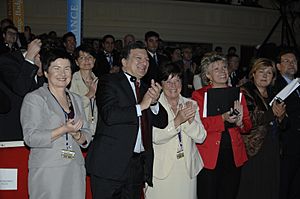
Leading the Conservative Party
She was the deputy leader of the Conservative Party from 2002 to 2004. In 2004, she became the main leader of the party.
After the 2009 elections, the party realized they needed a new approach. Solberg changed her focus from just cutting taxes to reforming and managing public services more efficiently. She wanted to improve the welfare state rather than reduce it.
In 2011, she wrote a book called People, Not Billions. This book shared her new ideas for the party. She visited schools, health centers, and small towns. She explained that her goal was to create new jobs, improve infrastructure, and make the economy stronger. She aimed to reduce Norway's reliance on oil income. She also promised to keep education and healthcare free for everyone.
Prime Minister of Norway (2013–2021)

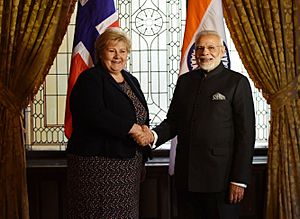
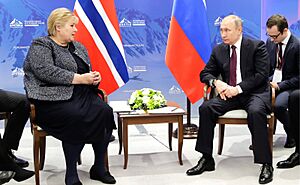
Erna Solberg became the head of Norway's government after winning the general election on September 9, 2013. She was appointed prime minister on October 16, 2013. She was the second woman to be prime minister of Norway, after Gro Harlem Brundtland.
Her government was re-elected in 2017. This made Solberg the first conservative leader in Norway to win re-election since the 1980s. Her government included the Conservative and Progress parties at first. Later, the Liberal Party joined in January 2018, and the Christian Democratic Party joined in January 2019. This gave her government a majority in Parliament.
As prime minister, Erna Solberg worked on many national issues. She also focused on global solutions for development, economic growth, and solving conflicts.
She faced challenges within her government, which led to the Progress Party leaving the coalition.
During the migration crisis in 2015, she was known for her firm management of the situation. Her government introduced measures to support businesses when oil prices fell in March 2020. These included making it easier for companies to temporarily lay off employees and offering tax benefits.
COVID-19 Pandemic in Norway
In 2021, during the COVID-19 pandemic, Solberg broke national health guidelines. She celebrated her 60th birthday at a restaurant with her husband and 13 family members. The rules stated that restaurants could only have 10 people from the same group. She apologized for this and said she should have known better. She was fined 20,000 Norwegian kroner (about $2,352) after a police investigation.
On September 24, 2021, her government announced that most national COVID-19 measures would be lifted the next day. This officially reopened the country.
International Work
As Prime Minister, Solberg was a strong supporter of international cooperation and security. She had also led the Norwegian group at the NATO Parliamentary Assembly.
In 2018, she brought together a group of global leaders to discuss the sustainable ocean economy. She also raised this topic at the G7 Summit. Her government supported the World Bank's PROBLUE initiative, which aims to prevent damage to the oceans.
From 2016, she co-chaired the UN Secretary General's group that promotes the Sustainable Development Goals. She was especially interested in ensuring that everyone has access to good education, particularly girls and children in conflict areas.
Solberg believed that traditional aid is still needed in poor and conflict-affected parts of the world. However, she also emphasized that the Sustainable Development Goals look at global development in a complete way, combining economic, social, and environmental factors.
She showed a special interest in gender issues, like girls' rights and education. She hoped that by 2030, no factors like poverty or cultural beliefs would stop young girls from achieving their dreams.
In 2018, she received the first Global Citizen World Leader Award for her international efforts.
In October 2019, she criticized Turkey's military action in Kurdish areas of Syria. However, she did not support removing Turkey from NATO.
In her speech to the UN General Assembly in 2019, she spoke about Norway's goal to get a temporary seat on the Security Council for 2021–2022. She stressed that the UN needs to be stronger and that countries need to work together to solve global problems like climate change and terrorism.
In May 2021, it was reported that the Danish Defence Intelligence Service had worked with the US National Security Agency to listen in on other EU leaders. Solberg said this was "unacceptable" if close allies were spying on each other.
Other News Stories
In 2014, she attended a meeting about agriculture and food. She also criticized the European Court over rules about keeping phone and internet data.
In 2017, the Russian Embassy in Oslo accused Norwegian officials of using "anti-Russian rhetoric." Solberg responded by saying this was an example of Russian propaganda that often appears when security policy is discussed.
Solberg worked to improve China–Norway relations, which had been difficult since the Norwegian Nobel Committee gave the Nobel Peace Prize to Chinese activist Liu Xiaobo in 2010. When Liu Xiaobo died in 2017, Solberg expressed deep sadness. She said he was a key voice for human rights in China.
End of Premiership
In the 2021 election, parties on the center-left won more seats. Erna Solberg accepted the defeat, and her government stepped down.
Post Premiership
On May 20, 2022, it was announced that Solberg became a board member of Global Citizen. She said she joined because Global Citizen has a great potential to encourage people, especially young people, to fight poverty and achieve the UN's sustainability goals.
On November 13, 2023, Solberg announced that she would continue as the leader of the Conservative Party. She also stated she would be their candidate for prime minister in the 2025 parliamentary election.
In the 2023 Norwegian local elections, the Conservative Party won the most votes under Solberg's leadership. This was the first time since 1924 that the Labour Party did not win the most votes in a national election.
Husband's Stock Trading Issue
Before the 2023 local elections, media reported that Solberg's husband, Sindre Finnes, had bought and sold many stocks while she was prime minister. Solberg stated she was not aware of his specific purchases. She had also said she would not be involved in decisions related to companies where her husband owned stocks. A list of his many stock transactions was released after the election. Solberg issued a public apology. Authorities looked into the matter but decided not to open a formal investigation into Finnes.
In November 2023, Solberg answered questions from a parliamentary committee about the issue. It was estimated that Finnes bought over 112 million Norwegian kroner in stocks during her time as prime minister. Media reports suggested that Solberg had a conflict of interest, even if she did not know about every transaction.
Reports also indicated that some of Solberg's advisors did not properly save important emails with her husband about this conflict of interest. These documents were not made public for over 10 years.
Honours
National Honours
 Norway Commander of the Order of St. Olav (2005)
Norway Commander of the Order of St. Olav (2005) Norway King Harald V's Jubilee Medal 1991–2016 (2016)
Norway King Harald V's Jubilee Medal 1991–2016 (2016)
See also
 In Spanish: Erna Solberg para niños
In Spanish: Erna Solberg para niños


